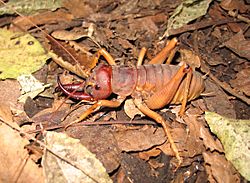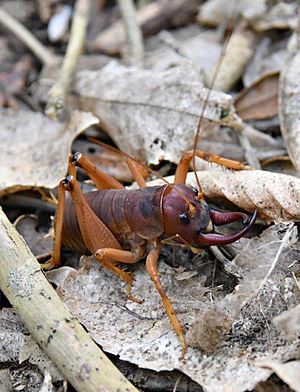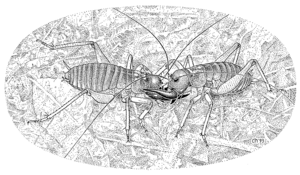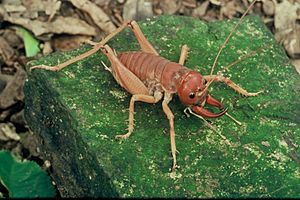Mercury Islands tusked wētā facts for kids
Quick facts for kids Mercury Islands tusked wētā |
|
|---|---|
 |
|
| Conservation status | |
 Nationally Critical (NZ TCS) |
|
| Scientific classification | |
| Kingdom: | |
| Phylum: | |
| Class: | |
| Order: | |
| Suborder: | |
| Family: |
Anostostomatidae
|
| Genus: |
Motuweta
|
| Species: |
M. isolata
|
| Binomial name | |
| Motuweta isolata Johns, 1997
|
|
The Mercury Islands tusked wētā (also called the Middle Island tusked wētā) is a big insect that can't fly. Its scientific name is Motuweta isolata. It was found in 1970 on a tiny island in New Zealand.
Male tusked wētā have huge tusks they use to fight each other. This amazing insect was almost lost forever! Luckily, a special program helped save it. All the tusked wētā alive today come from just one male and two females that were caught and bred in 1998, right before they disappeared from the wild. The Mercury Islands tusked wētā is the biggest of all tusked wētā species. It is also the most endangered wētā, meaning it is in serious danger of becoming extinct. The Department of Conservation calls it "Nationally Critical."
Contents
Discovering the Tusked Wētā
The Motuweta isolata was first found in 1970. It was discovered on Middle Island (which is called Atiu in Māori). This island is part of the Mercury Islands group. A scientist named Tony Whitaker found it and gave it the nickname "Jaws."
It took a long time for scientists to study this wētā. More samples were collected 15 years later. Then, it took another 12 years for the species to get its official name in 1997. Its name, Motuweta, comes from the Māori word motu, which means island.
Scientists first thought this wētā was very different from other tusked wētā. But later, genetic research showed that all three known tusked wētā species are actually very closely related. Their closest relatives live in New Caledonia.
What Does the Tusked Wētā Look Like?
The Mercury Islands tusked wētā is the largest type of tusked wētā. It can grow up to 90 millimeters (about 3.5 inches) long. Wētā raised in captivity can be quite heavy. Males can weigh 28 grams, and females can weigh 37 grams. Wild wētā are usually a bit smaller.
Adult male wētā have long, brown tusks that curve out from their mouths. These tusks stick out far in front of their heads. The size of these tusks can be very different between males. They use their tusks to "spar" or push against other males. They try to flip each other over in these fights.
If a tusked wētā feels bothered, it will raise its front legs and hiss. It might also gnash its jaws together. They can make a rasping noise by rubbing their back legs against their bodies. Males can also rub their tusks together to make a sound. Both male and female wētā will also release a bad-smelling liquid if they are disturbed. Even with these displays, they rarely bite people when handled.
Life Cycle of the Tusked Wētā
Wētā eggs are laid in the soil. It can take anywhere from three to nine months for the eggs to hatch. After hatching, it takes 16 to 17 months for a young wētā to grow into an adult. Adult wētā then live for another 6 to 10 months after their last molt (when they shed their skin).
Where Do They Live and What Do They Eat?
Mercury Islands tusked wētā are active at night. During the day, they hide underground. They dig a burrow and a special underground room. They make the walls of this room smooth with their saliva. Then, they back into the burrow and seal the entrance with a plug made of soil and saliva.
They don't like to come out often. They usually only appear on the darkest nights when it is warm and wet, and there isn't much moonlight. This behavior helps them avoid predators like tuatara and lizards that live on the forest floor. Wētā that have been moved to islands with fewer predators are more willing to come out at night.
The Mercury Islands tusked wētā mostly eats other small creatures found in the leaf litter. This means they are mostly carnivorous. However, if they are kept in captivity, they will also eat plant material.
Saving the Mercury Islands Tusked Wētā
The Mercury Islands tusked wētā was naturally found on only one island: Atiu, or Middle Island. This island is part of the Mercury Islands group, which is off the eastern coast of the Coromandel Peninsula. Middle Island is small, about 13 hectares (32 acres). It does not have any introduced mammals, like rats, that could harm the wētā. However, it does have other predators. These include giant centipedes, tuatara, lizards, and morepork (a type of owl). The island also has other types of wētā and many seabirds that nest in burrows.
During the 1990s, the number of M. isolata on Middle Island started to drop. Scientists thought there were fewer than 200 left. So, a special breeding program was started. Between 1993 and 1998, scientists like Rob Chappell caught a few wētā to breed them. The first attempt didn't work, but in 1998, they tried again. This time, they caught two female and one male wētā. This group produced 181 baby wētā! And then, 77 more in the next generation.
In 2000 and 2001, 130 of these captive-bred wētā were released onto two other islands in the Mercury group. These islands were Moturehu (Double Island) and Whakau (Red Mercury). These islands had been cleared of their only mammal predator, the kiore, in earlier years. Scientists watched these wētā closely. They saw young wētā, which meant the wētā were breeding and growing on these new islands. The species has continued to spread and increase on both islands. Tracking showed they were moving about 50 to 100 meters each year from where they were released on Red Mercury.
This breeding program was started just in time! The tusked wētā were disappearing from Middle Island. In the 1980s, you could see dozens in one night. But between 1998 and 2003, biologists searched for 64 nights and found only four. No tusked wētā have been seen on Middle Island since 2001. It's possible that Middle Island became too dry, and a long drought caused the wētā population there to die out.
One concern for the Mercury Islands tusked wētā is their genetic diversity. From 2000 to 2009, 567 captive-bred wētā were released onto six islands. All of these wētā came from just two females and one male caught in 1998. Besides Moturehu and Red Mercury, there are now healthy populations of M. isolata on Ohinau, Stanley, Korapuki, and Cuvier Islands. All these islands have been cleared of mammal predators. Thanks to these efforts, the Mercury Islands tusked wētā now seems safe from extinction.




